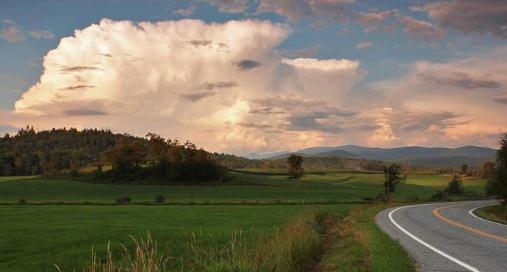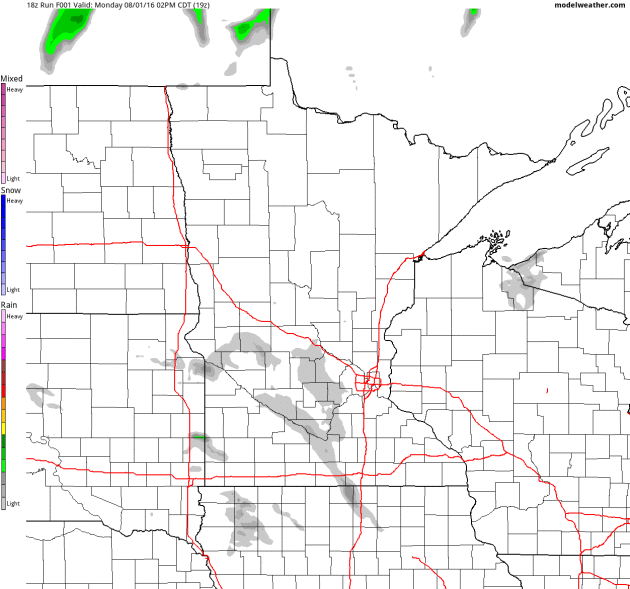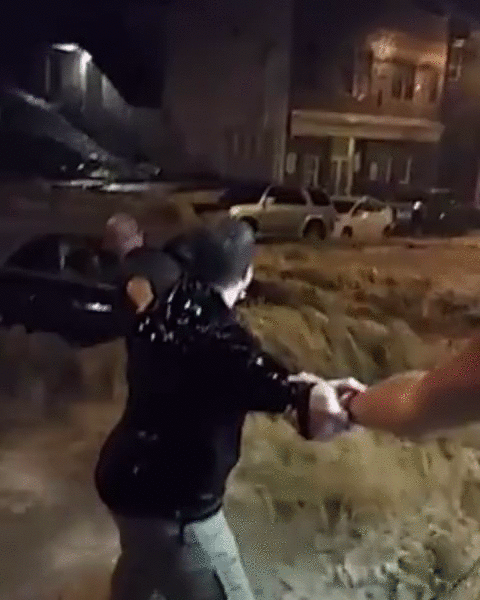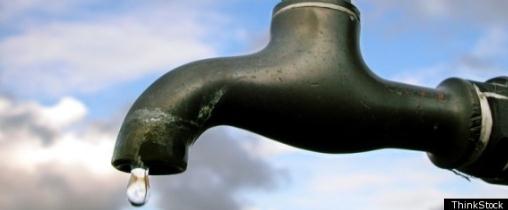85 F. high in the Twin Cities Monday.
83 F. average high on August 1.
86 F. high on August 1, 2015.
August 2, 1831: Unseasonably cool air moves into Minnesota with light frost reported at Ft. Snelling.
Take Steps To Lower Your Summer Weather RiskIf you're not a little paranoid you may not be paying attention.
Every
day we live with risk, and we take steps to lower the potential for
disaster. We wear seat belts and helmets; take our kids by the hand
crossing busy intersections.
Your odds of becoming a weather
statistic are exceedingly small but there are steps you can take to
avoid tragically unpleasant surprises.
Come indoors when you hear
the first growl of thunder. Lightning is an equal opportunity killer. In
a building or car you're generally fine. In light of the Ellicott City,
Maryland super-flood remember that flash flooding claims many people in
their vehicles, especially at night. "Turn around - don't drown". If
you're camping take along a portable NOAA Weather Radio, and have a
shelter scoped out nearby. Avoid camping next to streams, which flood
rapidly when heavy rains fall upstream.
The worst of the heat stays south of Minnesota into mid-August. T-storms flare up today; again
Thursday
before a late week dip in humidity. We hit 90F by midweek with drippy
dew points, but I suspect the worst of the heat may be behind us.
Dark Clouds Loom for Farmers and their Bankers as Crop Prices Languish.
Has the weather been "too good" across the corn belt? Or, as the
article points out, some are "hoping for a drought somewhere else" to
boost prices. Here's an excerpt at
Star Tribune: "
Midwest
farmers and bankers face a reckoning this fall as low crop prices and a
projected bumper harvest will produce financial losses for the second
consecutive year. After nearly a decade of boom times, farmers in the
Upper Midwest lost $58 per acre on corn last year and almost $3 per acre
on soybeans. Despite that, bankers around the region refinanced
farmers’ debt and lines of credit on favorable terms. But with a second
year of losses ahead for many farms, patience among lenders is running
thin. A credit crunch now looms that would mark a decisive turn in the
farm economy..."
 Minnesota: Drought-Free, For Now
Minnesota: Drought-Free, For Now.
National Drought Monitor data shows South Dakota drying out rapidly,
pockets of drought across Lower Michigan. But soil moisture across most
of Minnesota and Wisconsin is in good shape, in spite of the transition
from El Nino to La Nina, which is often accompanied by drought. Not yet.
Map:
Aeris Maps Platform.
Scattered Showers and T-storms Today.
Winds swing around to the north or northwest today, but a few
instability T-showers may still sprout, especially south and east of the
MSP metro area this afternoon as a line of convection redevelops. Drier
weather returns for Wednesday. 4km NAM Future Radar: NOAA and
AerisWeather.
Uncomfortable Wednesday and Thursday.
Factoring highs near 90F both days with dew points rising into the 70s
it may feel like mid to upper 90s across much of the region by midweek.
Source: Aeris Enterprise Mobile.
Heating Up - Not as Nasty as 2 Weeks Ago.
The 72 hour forecast is sweaty; by Thursday you'll be welcoming a few
cooling showers and T-storms along the leading edge of drier, Canadian
air. By Thursday a dew point above 70F couldmake it feel like upper 90s
to near 100F. Source: Aeris Enterprise.
Seen From Space: Eight Days of a Blazing California Wildfire. Here's a clip from
Discover Magazine: "
Since
it started on July 22, the Soberanes Fire along California’s Big Sur
coast has scorched at least 33,668 acres — an area nearly two and third
times the size of Manhattan. Along the way it has destroyed 68
structures and resulted in the death of one bulldozer operator. More
than 5,000 firefighters are battling the blaze, equipped with 511 fire
engines, 40 water tenders, 14 helicopters, six air tankers, and 67
bulldozers. And after eight days, the Soberanes Fire is still just 15
percent contained. (For the latest on the fire, check out updates from
the Incident Information System here.)..."
Image credit: "
Click
this screenshot to watch an animation of GOES-West weather satellite
images showing the blazing Soberanes Fire between July 22, 2016, when it
started, and July 30th." (Source: RAMMB)
This Is How an "Off-The-Charts" Flood Ravaged Ellicott City. More perspective and excellent analysis on another 1 in 1,000 year flood event from
Capital Weather Gang: "...
But
the best any meteorologist could do was portray the threat region in
broad strokes. The reason: Summertime flash floods almost always issue
forth from highly localized convective storms, dropping vast amounts of
water on small locations. Flash flood warning essentially becomes a
“nowcasting” exercise: Once those storms have formed, you try to stay
ahead of where they will track and how long they will persist. There is
almost always never any lead time..."

Incredible Footage.
I can't think of a better cautionary tale about driving through a
flooded road, especially at night when it's impossible to estimate the
depth of rapidly-flowing water. Brave bystanders made a human chain to
rescue the woman stranded in the VW bug; here's an excerpt from
Sara Arditti's Facebook post: "
Unbelievable
video shot by my husband Dave during the flood as he and several other
men rescue a woman from her car floating down Main St right in front of
our business, Still Life Gallery at about 8:30pm July 30th. Dave was at
the top of the human chain holding the next man's hand and filming with
the other. The man who got washed away was incredibly lucky..."
More Photos and Videos From a "Ruined" Ellicott City. Capital Weather Gang has more details on another jaw-dropping rain event.
* At least 2 people died during severe flash flooding, according to the
Baltimore Sun. More details and perspective from
WJLA-TV in Washington D.C. - the
Wall Street Journal and
New York Times.
Please Don't Let a Tornado Interrupt Your Drinking.
Check out the tornado spinning high above a village pub in Suffolk
(UK). No running or screaming - impressive! Credit: "Geoff Robinsonn
Photography". These pics were caught by pub chef Phil Hannam. Photo and
story credit:
The Sun.
Potential for Tropical Storm Earl. Update:
NHC
now predicts an 80% risk of tropical storm formation within 48 hours,
but 90% over the next 5 days. Tropical storm force winds are impacting
Jamaica and the Caymans. Right now most tropical models take "Earl"
south of the Gulf of Mexico, still more of a risk to Cancun and the rest
of Mexico. Forecast model track:
Tropical Tidbits.
Where Are The World's Most Water-Stressed Cities? The Guardian takes a look at the most precious natural resource of the 21st century: "...
Water stress
– where the human or ecological demand for water is not met – is caused
by a variety of factors. There’s the physical scarcity of water due to
lack of rainfall, the natural aridity of the area and, increasingly,
changes in climate; but poor management and investment in water
infrastructure, and pollution, also play their parts. The problem
affects an estimated 2.7 billion people for at least one month of every year, across every continent – and is particularly pressing in cities as the global urban population grows. At present, almost four billion people live in cities, with a further 2.5 billion expected to join them by 2050..."
Photo credit: "
Last year, California’s cities were required to cut their water usage by up to 35%." Photograph: Lucy Nicholson/Reuters.
Storing Carbon Underground May Be Safer Than We Thought. Chelsea Harvey explains at
The Washington Post: "...
While the debate isn’t likely to be resolved any time soon, a new study
— just published Thursday in the journal Nature Communications — has
addressed at least one of the concerns associated with carbon storage:
its safety. In the past, critics have suggested that carbon dioxide
stored underground may be able to corrode the rock layers above it and
eventually escape, a possibility that’s been supported by some modeling
and laboratory studies. This would be bad for the climate, of course,
but some environmental and public health advocates have also worried
that escaped carbon dioxide in large volumes could damage the water or air quality of nearby communities. But the new study suggests that such concerns may be overblown..."
Photo credit: "Construction continues on Southern Co.’s Kemper County power plant near Meridian, Mississippi, U.S., on Tuesday, Feb. 25, 2014." (Photographer: Gary Tramontina/Bloomberg).

Can America's First Floating Wind Farm Shake Off Environmental Concerns? The Guardian reports: "The deep waters off the coast of California
could become home to the country’s largest offshore wind energy project
and a test case for a technology that is still in its infancy. The
765-megawatt project, proposed by Seattle-based Trident Winds,
would sit about 25 miles off California’s central coast, near the town
of Cambria. If built, it will be larger than the 630-megawatt London Array
off the coast of Kent, – the world’s largest working offshore wind farm
that began operating in 2013. The Trident project, which could power
more than 200,000 homes, reflects an interest by the US to embrace
offshore wind energy as part of a broader strategy to develop low-carbon
electricity sources..."
Meet The Man Who Is Trying to Change the GOP on Clean Energy. Details via
TheHill: "...
Unlike
environmentalists, who mostly promote renewable energy sources like
wind and solar power, Faison is a champion of options that he says don’t
get respect they deserve, including nuclear power, hydropower, coal
with carbon capture and natural gas. His main selling point for
conservatives is strictly political. Research that he and others have
commissioned shows that support for clean energy is the top issue that
can sway an undecided voter. “No other issue does more to change a
persuadable voter’s mind than clean energy,” he said. “It is the No. 1
peel-away issue.” Faison says he’s tired of watching the left take
control of environmental policy matters and forcing Republicans —
particularly in tough election races — to be on defense..."
How We Use The Sun To Reduce Climate Change and Make Fuel and Other Stuff At The Same Time.
A tortured headline, but I thought it was worth sharing - more
innovation to help us power the economy and even reverse the amount of
CO2 in the atmosphere. Details via
Forbes: "...
The
new breakthrough from the University of Illinois at Chicago is more
like an artificial leaf, mimicking he process of photosynthesis in which
plants use sunlight and carbon dioxide to create fuel in the form of
sugars. “The new solar cell is not photovoltaic — it’s photosynthetic,” says Amin Salehi-Khojin, assistant professor at UIC and senior author on a paper describing the technology in the journal Science. “Instead
of producing energy in an unsustainable one-way route from fossil fuels
to greenhouse gas, we can now reverse the process and recycle
atmospheric carbon into fuel using sunlight...”
Photo credit: University of Illinois-Chicago.
The Strange World of Japanese Hangover Cures. Having been to Tokyo, Kyoto and Osaka I can vouch for this first-hand. Details from
Atlas Obscura: "...
But
perhaps no country has stranger and more thorough hangover cures than
Japan. What makes Japanese cures different is their breadth: the
majority of other national hangover cures are simply foods or drinks. In
Japan the culture of curing a hangover is closer to homeopathic
medicine: these are preventative or curative potions designed to heal
specific organs. Even the foods that make up Japanese hangover cures are
specifically thought to heal organs, in direct contrast to, say, the
British full breakfast or its American descendent, the greasy diner
breakfast...."
Photo credit: "
A Pocari Sweat vending machine in Japan." (Photo: jam_232/CC BY 2.0)
 TODAY
TODAY: Leftover clouds, few passing T-storms. Winds: NW 5-10. High: 86
TUESDAY NIGHT: Partial clearing, drying out. Low: 68
WEDNESDAY: Sunny and drier - still hot and sticky. Feels like mid to upper 90s. High: 89
THURSDAY: Muggy with showers and T-storms likely. Wake-up: 73. High: near 90
FRIDAY: Sunny and less humid. Winds: NW 8-13. Wake-up: 65. High: 84
SATURDAY: Lingering sun, nicer day of weekend? Winds: NW 5-10. Wake-up: 64. High: 83
SUNDAY: Chance of showers and T-storms. Winds: E 5-10. Wake-up: 66. High: 81
MONDAY: T-storms taper early, then some sun. Wake-up: 65. High: 82
Climate Stories...
Climate Change Divide Burst to Forefront in Presidential Campaign. Here's an excerpt of a
New York Times story: "...
Mrs. Clinton’s opponent in the November election, Donald J. Trump,
has gone further than any other Republican presidential nominee in
opposing climate change policy. He often mocks the established science
of human-caused climate change and dismisses it as a hoax. The
Republican platform calls climate change policy “the triumph of
extremism over common sense.” The divide between the two parties over
the issue is the widest it has been in the decades since it emerged as a
public policy matter. That is all the more remarkable given that during
the 2008 election, the Democratic and Republican positions on climate
change were almost identical..."

Looking, Quickly, For The Fingerprints of Climate Change. Here's an excerpt from a fascinating
New York Times article: "...
David W. Titley, a professor of meteorology at Pennsylvania State University who was chairman of a National Academies committee
that looked at developments in the field of climate-change attribution,
said that at this point studies of heat waves and other
extreme-temperature events appeared to produce the most reliable
assessments. Studies of extreme rainfall are considered less reliable in
finding links to climate change, and studies of events like wildfires
and severe thunderstorms even less reliable. Still, Dr. Titley said,
such studies are worth doing, as long as certain conditions are met..."
Image montage: Environment America.
The Middle East is Baking. An article at
The Economist argues that climate change, even more than perpetual war, is making the Middle East increasingly uninhabitable: "...
The
UN’s Environmental Agency (UNEA) released a report in May calculating
that the harsh climate claims 230,000 lives annually in West Asia (the
Arabian Peninsula and the fertile crescent), making it a greater killer
than war. By somewhere between 2070 and 2100, predicts Dr Elfatih
Eltahir, professor of climate at Massachusetts Institute of Technology,
the temperature in much of the Gulf could have reached levels beyond
which any exposure for more than six hours would be intolerable even for
the fittest of humans. Current highs might seem like a normal summer
day. Mecca’s outdoor pilgrimage could become hazardous. “We’re seeing
just the tip of the iceberg,” he adds. “Extreme temperatures will be
much worse in the future...” (Photo credit: EPA).

Climate Threat to our Water Supplies. Here's an excerpt of an Op-Ed at
The Milwaukee Journal Sentinel: "...
What
can we do? Climate change has been inadequately addressed in both
management and policies, and there are gaps in knowledge. The major
challenge in water governance is to align water use with demand at
levels that protect the environment and to support and enforce effective
legislation. People, who should pay for water, pay very little. Yet,
the poorest in developing countries can pay up to 40% of their income
for this basic necessity. Groundwater extraction must be regulated, and
polluters should pay...."
Image credit: ThinkStock.
 My Turn: Climate Change is a Moral Issue.
My Turn: Climate Change is a Moral Issue. An Op-Ed at
Juneau Empire in Alaska resonated; here's an excerpt: "...
Make
no mistake: global warming is a religious issue. Climate change is a
moral evil on many levels. It stems from overconsumption and is
perpetuated by a heedless desire to continue a status quo we know is
destructive. It’s a profound injustice, since its initial effects are
falling hardest on the poorer members of human society who have done the
least to cause it. It is also an injustice to generations newly arrived
or yet-to-be born, as there is little harm greater than leaving our
descendants a ravaged and exhausted environment. Finally, global
warming’s ability to cause mass extinctions of the millions of creatures
that share the earth with us reveals a sacrilegious contempt for the
creation we were entrusted with. Some may say that this is simply God’s
will. We profoundly disagree..."

 Warming Waters
Warming Waters.
So far we haven't seen a significant uptick in hurricanes in the
Atlantic basin, but the Pacific (bigger and even warmer) has seen
record numbers of extreme category 5 hurricanes and typhoons in recent
years. Graphics above: Climate Central.






No comments:
Post a Comment